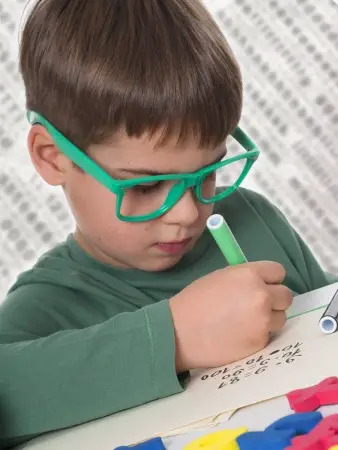With the use of more screens in everyday activities and school work, your child’s eyes may be suffering. The American Optometric Association shares the signs of vision problems in children, how to limit the possibility of vision problems, and when your child should have comprehensive eye exams.
 Computers and Smart Boards are a common staple in today’s classrooms, but now with programs such as “bring your own device” to school, smartphones and tablets are seeing increased use in schools as well. As these devices transition between home and the classroom, it’s clear that the use of these technologies is evolving from a trend to a necessity, even among the youngest students. According to the American Optometric Association’s 2013 American Eye-Q® survey, 85 percent of parents indicate their children use an electronic device up to four hours per day.
Computers and Smart Boards are a common staple in today’s classrooms, but now with programs such as “bring your own device” to school, smartphones and tablets are seeing increased use in schools as well. As these devices transition between home and the classroom, it’s clear that the use of these technologies is evolving from a trend to a necessity, even among the youngest students. According to the American Optometric Association’s 2013 American Eye-Q® survey, 85 percent of parents indicate their children use an electronic device up to four hours per day.
This is no surprise as the survey also indicates 41 percent of children have their own smartphone or tablet and 32 percent use both e-books and textbooks at school. Additionally, 66 percent of children use a computer or tablet to do homework or study. With the consistent use of electronic devices throughout the day and evening, children of all ages can face a number of visual challenges.
“When children stare at screens for hours each day, it may cause visual discomfort that can interfere with their ability to focus and learn,” said Kimberly Friedman, O.D., AOA spokesperson and pediatric vision specialist. “As a mom and an eye doctor, I know first-hand just how important it is for school-aged children to receive comprehensive eye examinations prior to heading back into a classroom.”
Despite the increase in technology use, only one-third (31 percent) of parents have strong concerns that their children may damage their eyes as a result of prolonged exposure. Although ongoing use won’t damage vision, regular, lengthy use of technology at school or for homework can lead to a temporary vision condition called computer vision syndrome. Symptoms of CVS can include eyestrain, headaches, fatigue, burning or tired eyes, loss of focus, blurred vision, double vision, or head and neck pain. The AOA urges students to rest their eyes by following the 20-20-20 rule. When using technology or doing near work, take a 20-second break every 20 minutes and view something 20 feet away.
As children of all ages become more frequent users of technology, eye doctors are increasingly warning parents about the potential signs or symptoms of CVS or undiagnosed vision problems that may arise and indicate the need for an eye exam:
Preschool and kindergarten: At home, little ones may begin to play games on a tablet or smartphone, while at school they tend to learn early lessons about how to use a computer. The AOA suggests limiting tech time to two hours or less each day and increasing the font size of the text on the screen in order to make it easier on eyes. During this stage, parents should be aware of physical signs that may flag a potential vision problem and ask themselves the following questions:
- Are my child’s eyes aligned properly or does one or both eyes turn inward or outward?
- Does my child frequently rub his or her eyes or blink excessively when doing near work?
- Does my child experience difficulty recognizing colors, shapes, letters, and numbers?
Elementary school: At this age, children continue to use smartphones, play with portable gaming devices, and spend hours on computers at school and at home. Encourage kids to use cell phones only for quick tasks such as texting, and to position all devices half an arm’s length away from the eyes and slightly below eye level. Children should also take frequent breaks and move around or change positions often while working on a computer. Parents of this age group should ask children and themselves the following questions to learn more about the health of their vision:
- Do words seem to “swim” on a screen or in a printed book or do they lose their place frequently when reading?
- Does my child experience frequent headaches during the school week or while performing close up visual work?
- Are my child’s grades high in non-visual classes and lower in other, more visually focused classes like math or reading?
Middle and high school: With computers becoming a staple at school and for homework, along with increased smartphone usage, middle and high schoolers should be reminded that computers should be positioned 20 to 28 inches away from their eyes, and the top of the screen should be at eye level, allowing them to look down at the screen. When at home, kids should use ergonomic desk areas or gaming chairs and to prevent glare on screens, incorporate low-wattage light bulbs or drapes in the room. As for digital devices, brightness or background color settings should be adjusted to keep vision comfortable. Parents can stay involved with their older children’s vision by knowing:
- How long can my child read before they need to take a visual break?
- Does my child perform with a lowered level of comprehension or efficiency?
- Does my child experience discomfort, fatigue or have a short attention span?
“I look for a variety of indicators using various tests and instruments during a comprehensive eye exam,” Dr. Friedman said. “But parents play an important role by alerting their eye doctor of certain behaviors and warning signs that may indicate a problem between eye exams.”
Additional warning signs parents should watch out for include:
- Squinting while reading or watching television
- Turning or tilting head or covering an eye
- Consistently performing below potential or struggling to complete homework
- Having behavioral problems
The AOA also warns that 1 in 4 children has an undiagnosed vision problem simply because they may not recognize that their eyesight isn’t optimal or is changing.
“Comprehensive eye exams are one of the most important investments a parent can make to help maximize their child’s education and contribute to overall health and well-being, especially since some vision problems may not have warning signs,” Dr. Friedman added. “Unfortunately, parents and educators often incorrectly assume that if a child passes a school screening, their vision is fine.”
Beginning in 2014, pediatric vision care will be one of the Affordable Care Act’s Essential Health Benefits. This means millions of children will gain direct access to local optometrists for comprehensive eye exams and treatment, including medical eye care, through health insurance. The AOA recommends that a child’s first eye exam take place at 6 months of age. Unless problems are detected, exams should then be given at age 3, before a child enters kindergarten, and yearly thereafter. To find an optometrist in your area, or for additional information on children’s vision and the importance of back-to-school eye exams, visit aoa.org.


















